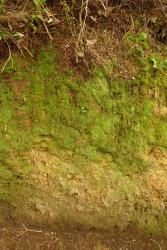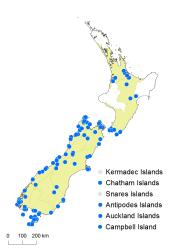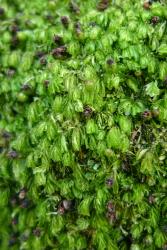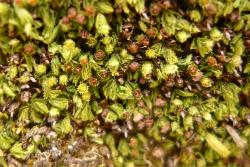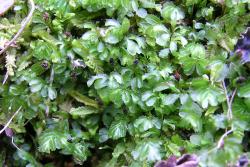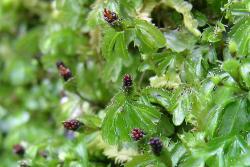- ≡ Meringium minimum (A.Rich.) Copel., Philipp. J. Sci. 73: 457 (1941)
- = Hymenophyllum pygmaeum Colenso, Trans. & Proc. New Zealand Inst. 13: 376 (1881)
Terrestrial or rupestral ferns or occasionally epiphytic. Rhizomes long-creeping, 0.1–0.2 mm diameter, bearing very scattered red-brown hairs up to 0.3 mm long. Fronds 6–30 mm long. Stipes 2–15 mm long, dark brown throughout, not winged, bearing very scattered hairs. Laminae 1-pinnatisect or 1-pinnatisect with pinnatifid secondary pinnae or 1-pinnate with pinnatifid secondary pinnae, ovate or elliptic or obovate or orbicular, 3–25 mm long, 3–12 mm wide, green, membranous, virtually glabrous. Rachises not winged or occasionally winged distally, dark brown to red-brown, glabrous or with a few very scattered hairs. Primary pinnae in 1–6 pairs, not overlapping, elliptic when undivided, ovate or elliptic or obovate when divided, the longest sometimes divided almost to the base to form 1 or 2 acroscopic segments, adnate to decurrent; distal portion of primary pinnae straight or recurved basiscopically; the longest primary pinnae variably positioned from base to apex of lamina, 2–9 mm long, 0.75–4 mm wide. Ultimate lamina segments oblong to elliptic, up to 5 mm long, 0.7–2.0 mm wide; apices acute or obtuse or truncate; margins deeply toothed, lacking a distinct border. Sori terminating the rachis, solitary, adnate or stalked; indusia bivalvate; indusial flaps elliptic or usually obovate, 2–4 mm long, apices obtuse or truncate, margins and outer surfaces spiny or toothed; receptacles exserted up to 2 mm.
Hymenophyllum minimum is one of the smallest filmy ferns in New Zealand. It is distinguished by its small size, toothed pinnae, a solitary sorus terminating each rachis, indusial flaps with toothed margins and spines on the outer surfaces, and receptacles that are often exserted for a short distance. When fertile, the usually stalked terminal sori will distinguish this species from other small species with toothed lamina margins, notably H. armstrongii, H. cupressiforme, H. peltatum and H. revolutum. Sterile fronds of H. minimum are usually simply pinnate and less divided than the latter three species, and lack the dark brown midribs and black marginal spines of H. armstrongii.
North Island: Auckland, Volcanic Plateau, Southern North Island.
South Island: Western Nelson, Sounds-Nelson, Marlborough, Westland, Canterbury, Otago, Southland, Fiordland.
Chatham Islands, Solander Island, Stewart Island, Antipodes Islands, Auckland Islands, Campbell Island.
Altitudinal range: 0–1650 m.
Hymenophyllum minimum has a very scattered distribution in coastal and lowland areas of the North Island, extending locally into montane areas. It is found from Mt Te Aroha south to Mt Pirongia, Rotorua and the Hawke’s Bay ranges, and again from Wellington to southern Wairarapa, extending from sea level to 1650 m in the Kaweka Ranges. It is absent from Gisborne, Taranaki and most of the central North Island and Hawke’s Bay regions. In the South Island it occupies coastal and lowland sites, extending locally to montane and subalpine areas. West of the main divide it occurs from north-west Nelson to Fiordland and Southland. There are also scattered populations east of the main divide and along the coast from Marlborough to the Catlins District. It ranges from sea level to 1650 m in the St Arnaud Range and extends to Solander Island, Stewart Island and all the subantarctic islands except the Snares Islands.
Grows most frequently on rocks, clay banks, logs and under overhangs, from exposed coastal sites to damp stream banks in mānuka, kānuka and Dracophyllum scrub, stunted southern rātā forest, beech forest or subalpine tussock. It often forms extensive mats on rock faces or turfs in exposed coastal habitats, but can also grow epiphytically on Melicytus ramiflorus, Metrosideros umbellata and Weinmannia racemosa. In the subantarctic it has been recorded growing on Carex sectoides in swamps.
n = 26 (Lovis in Dawson et al. 2000).
Hymenophyllum pumilio Rosenst. from New Caledonia was reduced to synonymy with H. minimum by Ebihara & Iwatsuki (2007), but the occurrence of the latter species in New Caledonia seemed improbable since it is absent from much of northern New Zealand. Perrie et al. (2016) reinstated H. pumilio as a New Caledonian endemic distinct from H. minimum.
Lovis (1982) demonstrated that Colenso’s Hymenophyllum pygmaeum was a synonym of H. minimum rather than H. revolutum, the species with which it had been compared by earlier authors, including Allan (1961).



